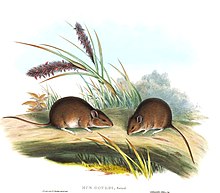Gould's mouse
This article needs additional citations for verification. (June 2015) |
| Gould's mouse | |
|---|---|

| |
| Scientific classification | |
| Domain: | Eukaryota |
| Kingdom: | Animalia |
| Phylum: | Chordata |
| Class: | Mammalia |
| Order: | Rodentia |
| Family: | Muridae |
| Genus: | Pseudomys |
| Species: | †P. gouldii
|
| Binomial name | |
| †Pseudomys gouldii (Waterhouse, 1839)
| |
Gould's mouse (Pseudomys gouldii) lived in eastern inland Australia, and was named after John Gould. It was slightly smaller than a black rat, and quite social, living in small family groups that sheltered by day in a nest of soft, dry grass in a burrow. It usually dug burrows at a depth of 15 cm under bushes. Gould's mouse was common and widespread before European settlement, but disappeared rapidly after the 1840s, perhaps being exterminated by cats. Alternatively, it may have been out-competed by the introduced rats and mice, succumbed to introduced diseases or been affected by grazing stock and changed fire regimes. Despite extensive survey work in its known range, the last specimens were collected in 1856–57, and it is presumed to be extinct.[1]
There is some speculation that this species was in fact an eastern population of the Shark Bay mouse (Pseudomys fieldi). Once the Alice Springs mouse was thought to be extinct but with genetic testing in 1998 scientists confirmed that the Alice Springs mouse was also the Shark Bay mouse, and this could also one day happen between Gould's mouse and the Shark Bay mouse.[citation needed]
References
- ^ a b Baillie, J. 2008. Pseudomys gouldii. 2011 IUCN Red List of Threatened Species. Archived 2014-06-27 at the Wayback Machine Downloaded on 23 September 2011.

